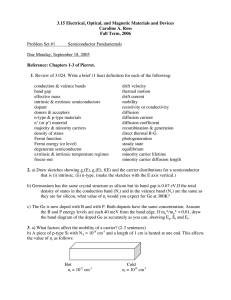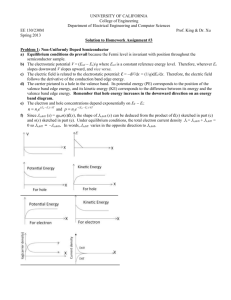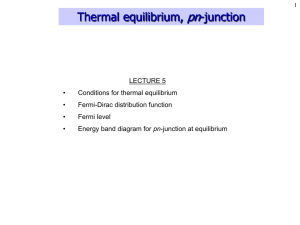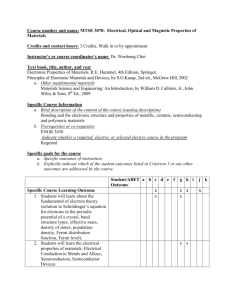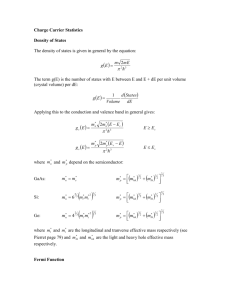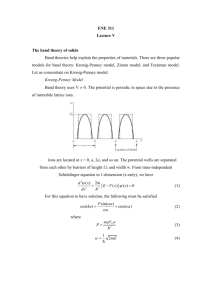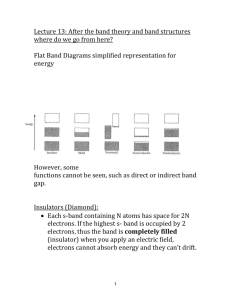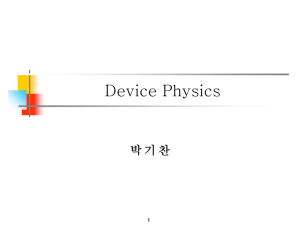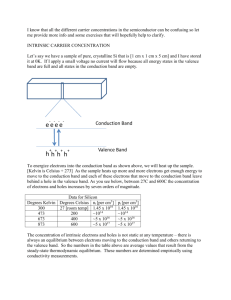Document
advertisement
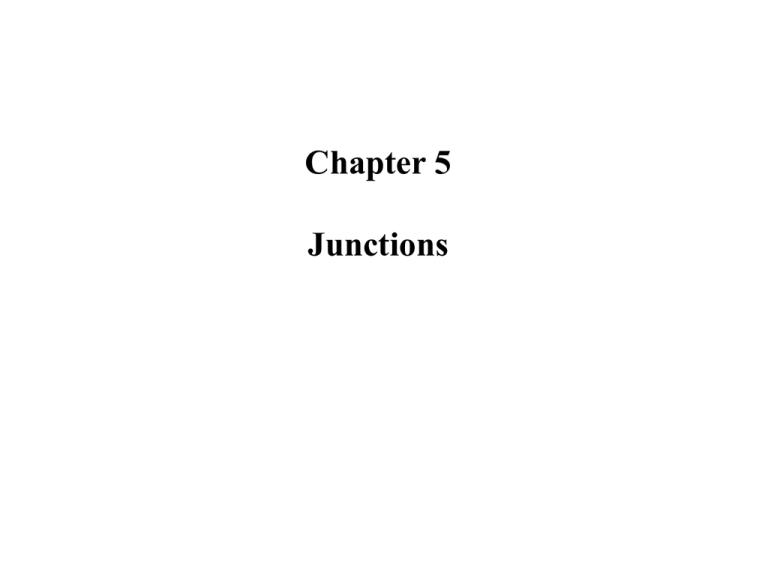
Chapter 5 Junctions 5.1 Introduction (chapter 3) 5.2 Equilibrium condition 5.2.1 Contact potential 5.2.2 Equilibrium Fermi level 5.2.3 Space charge at a junction 5.3 Forward bias 5.3.1 Irradiation Mask/Shield/Pattern (negative) Photoresist Silicon Oxide Silicon Develop Metal Oxide Lift off Fermi Gas and Density of State 1 2 p2 E mv 2 2m p h 2 k p k EF h / 2 1 2 p 2 2 k F2 EF m v 2 2m 2m kF Particle in a Infinite Well 2L n h nh p 2L 1 2 p 2 n2h2 En m v 2 2m 8m L2 For three-dimensional box (n12 n22 n32 )h 2 E 8m L2 Electron Energy Density (n12 n22 n32 )h 2 E 8m L2 nz n n x i n y j nz k ny nx Density of State ρ(E) nz n n x i n y j nz k ny nx (n12 n22 n32 )h 2 E 8m L2 Properties Dependent on Density of States Specificheat Cel 2 D( EF )kB2T / 3 Susceptibility el B2 D(EF ) Experiment provide information on density of state EDS spectrum Photoemission spectoscopy Seebeck effect Carrier concentration in semionductor Optical absorptiondetermination of dielectric constant Fermicontactterm in NMR de Haas van Alpheneffect Superconducting energy gap Josephson junctiontunneling in superconductors N(E)f(E) Ec Ec EF Ev Ev N(E)[1-f(E)] (a) Intrinsic 0 N (E ) 0.5 1 N (E) F (E) f (E ) N(E): Density of state f(E): Probability of occupation (Fermi-Dirac distribution function) N= N(E)dE: Total number of states per unit volume N= N(E)f(E)dE: Concentration of electrons in the conduction band Ec Ec EF Ev Ev Holes (a) Intrinsic 0 N (E ) 0.5 f (E ) 1 Carrier concentration Electrons Ec Ec EF Ev Ev Holes (a) Intrinsic Ec Ec EF Ev Ev (b) n-type Ec Ec EF Ev Ev (c) p-type 0 N (E ) 0.5 f (E ) 1 Carrier concentration EF 1 2m 3 / 2 1 / 2 (E) N (E) 2 ( 2 ) E 2 This density of state equation is derived from assumption of electron in the infinite well with vacuum medium, where the E is proportional to k2. We found that the free electron in the conduction band of semiconductor has local minimum of energy E versus wave number k. We can approximate the bottom portion of the curve as if E is still proportional to k2 and write down the similar energy-wave number equation as 2 k F2 EF 2m*n to describe the behavior of the free electrons, where mn* is the equivalent electron mass, which account for the electron accommodation to medium change. kF 2 k F2 EF 2m EF Eg kF If we prefer to the energy at the bottom of the conduction band as a nun-zero value of Ec instead of Ec = 0, The density of state equation can be further modified as 2m*n 3 / 2 ( E ) N ( E ) 2 ( 2 ) ( E Ec )1/ 2 2 1 2m*n 3 / 2 ( E ) N ( E ) 2 ( 2 ) ( E Ec )1/ 2 2 1 f ( E ) ( E EF ) / kT e ( EF E ) / kT e 1 1 n 0 2m 3 / 2 ( EF Ec ) / kT 1 / 2 E / kT N ( E ) f ( E )dE ( 2) e E e dE 2 0 2 1 2mkT 3 / 2 ( E F Ec ) / kT n 2( ) e 2 h ( given 0 x1/ 2e ax dx 2m*n kT 3 / 2 ( EF Ec ) / kT -( Ec E F ) / kT no 2( ) e N e c h2 po 2( 2m kT h * p 2 ) 3/ 2 e -( E F Ev ) / kT Nve -( E F Ev ) / kT 2a a ) 2m*n kT 3 / 2 N c 2( ) 2 h N v 2( 2m*p kT h2 )3 / 2 no Nce-( Ec EF ) / kT po Nv e-( EF Ev ) / kT (general) ni Nc e-( Ec Ei ) / kT pi Nv e-( Ei Ev ) / kT (intrinsic) and no po ni pi Nc: Effective density of state at bottom of C.B. Nv: Effective density of state at top of V.B. no: Concentration of electrons in the conduction band po: Concentration of holes in the valence band Ec: Conduction band edge Ev: Valence band edge EF: Fermi level Ei: Fermi level for the undoped semiconductor (intrinsic) no ni e( EF Ei ) / kT po pi e( Ei EF ) / kT where ni pi Fermi Level and Carrier Concentration of Intrinsic Semiconductor ni Nc e-( Ec Ei ) / kT pi Nv e-( Ei Ev ) / kT Ei and ni pi Ec Ev N kT ln v 2 2 Nc m*p Ec E v 3kT ln * 2 4 mn ni 2( 2kT 3 / 2 * * 3/4 Eg / 2 kT ) (m p mn ) e 2 h Example 3-5 A Si sample is doped with 1017 As atoms/cm3. What is the equilibrium hole concentration po at 300K? Where is EF relative to Ei? 5.1 Introduction 5.2 Equilibrium condition 5.2.1 Contact potential 5.2.2 Equilibrium Fermi level 5.2.3 Space charge at a junction 5.3 Forward bias 5.3.1 Electric field Electric field Einstein relationship (explained later) Einstein Relationship J p ( x) q n p( x) drift dp ( x) ( x) qD p dx diffusion • At equilibrium, no net current flows in a semiconductor. Jp(x) = 0 • Any fluctuation which would begin a diffusion current also sets up an electric field which redistributes carriers by drift. • An examination of the requirements for equilibrium indicates that the diffusion coefficient and mobility must be related. Einstein Relationship q c mp v p Drift q c vp p mp q ( p c ) mp hole Diffusion l l 1 dp ( p0 l )l dx l 2 c l : mean free path v p c 1 dp ( p0 l )l dx l 2 c dp dp l l v p c dp dp x l l dx dx v p l Dp c c dx dx l l 0 x l J p ( x) q x qD p dp dx ( Dp v p l ) Einstein Relationship l v p c Drift and diffusion q c ( p ) mp ( Dp v p l ) drift diffusion 1 1 2 m p v th kT 2 2 Dp kT p q diffusion Poisson's equation The derivation of Poisson's equation in electrostatics follows. SI units are used and Euclidean space is assumed. Starting with Gauss' law for electricity (also part of Maxwell's equations) in a differential control volume, we have: D f D f is the divergence operator. is the electric displacement field. is the free charge density (describing charges brought from outside). Assuming the medium is linear, isotropic, and homogeneous (see polarization density), then: D E is the permittivity of the medium. E is the electric field. By substitution and division, we have: f E http://en.wikipedia.org/wiki/Poisson's_equation F qE kQq r2 kQ E 2 r V Ed kQ r U qV q E d kQq r
